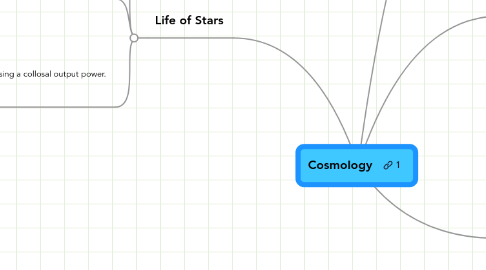Cosmology
by Lux Rav

1. Life of Stars
1.1. Protostar : 1)Nebula (interstellar gas cloud of hydrogen and dust) has denser regions. 2)There is a gravitational collapse to those dense regions G.P.E turns to K.E and thus temprature rises 3)Hydrogen burning occurs and radiation pressure expands the size of the star
1.2. Main Sequence : 4) Radiation pressure equals gravitational collapse and thus equilibrium is achieved 5)Complex fusion reactions can take place in the core producing carbon,silicon and iron.
1.3. End of the star : 6) The core collapses under gravitational attraction, allowing the helium shell to fuse to produce beryllyium carbon and oxygen , hydrogen starts to fuse aswell 7) This power production from the helium shell causes the surface of the star to swell to a red giant (<3 solar masses) ,super red giant (>3 solar masses). The surface temprature is cooler although the surface area has increased massively causing a collosal output power. 8)Helium nuclei in the outer shell reach a temperature of about 10^8 K and fuses at a phenomenal rate. 9)In a process known as the "helium flash" the material surrounding the core is ejected away as a planetary nebula
1.3.1. Star<3 Solar Masses : Produces a white dwarf which doesn't exceed the Chandrasekhar limit (1.4 Solar masses) prevented from further collapse by Fermi pressure brought about by Pauli's exclusion principle (no more than two electrons can exist in the same quantum state_ 10)A white dwarf is produced -No fusion occurs -Very dense -As the white dwarf becomes more and more compressed the electrons move freely around the star in a state called plasma.
1.3.2. Star>3 Solar masses : Produces a white dwarf which exceeds the Chandrasekhar limit (1.4 solar masses) 10)The high mass of the white dwarf means that gravitational attraction can cause the atoms to exceed Fermi pressure. 11)The neutrons combine with protons to produce nuetrons and nuetrinos , nuetrinoes escape the central core and is now made up of tightly packed nuetrons. 12)Outtershells sorrounding the core collapse and rebound off the solid nuetron core causing shockwaves exploding the surface layers of the star (Supernova) 13)For low mass stars the star remains as a nuetron star 14)For higher mass stars the gravitational attraction causes nuetron star to collapse in on itself.
2. Standard Model (Big Bang Theory)
2.1. Stage 1: Universe is infinitely small/dense, a singularity. All four forces are unified Stage 2: Inflates into a Quark and lepton Soup Stage 3: Quarks form to produce hadrons Stage 4: Primordial helium is formed by fusion Stage 5: Atoms form, nuclei capture electrons allowing the universe to become transparent (photons are free to travel around in the universe) Stage 6: Matter clumps together to form gas clouds, dust, stars and then galaxies. Universe is saturated with E.M radiation with a characteristic temperature of 2.7 K
2.2. Evidence:- 1)The universe is saturated with CMB at a characteristic temperature of 2.7 K, which is what Goerge Gamow predicted the photons released during the transparency to cool down too as space expands. (Also gives evidence for the isotropic nature of the universe) 2)There is an abundance of helium and light nuclei which could only be formed during the high temperatures of the big bang. 3)Red shift shows evidence of galaxies receding, and thus they must have started from a singularity.
3. Measuring the universe
3.1. Astronomical unit -( The average distance between the earth and the sun) 1AU = 1.5x10^11m -Usefull for measuring distances within our solar system
3.2. Light year -The distance travelled by light in a vacuum in one year -Useful for measuring distances between stars in our galaxy
3.3. Parsec -Distant stars tend to give parallax angles , this the shift in the apparent position of stars against their background stars as we observe it at different times of the year -The parsec is the distance that gives a parallax angle of 1 arc second -1 arc second = 1/3600 degrees -Distance (pc)= 1/ ( parallax) (arcseconds) -1 pc is 3.1x10^16m
4. Nature of the universe
4.1. We make 3 assumptions when we make measurements about the universe this is knows as the cosmological priniciple 1)Isotropic -it is the same in all directions 2)Homogeneous -It is the same in all places ( density is the same) 3)The laws of physics are the same everywhere
4.2. Olbers paradox -Olber realised that is the universe is infinite ,static and uniform the amount of stars should increase proportionally to r^2 and the intensity of light should decrease by 1/r^2 (inverse sqaure law) -If this is the case then the night sky should be bright. -Olbers paradox -For a infinte ,static uniform universe the night sky should be bright because of the light recieved from all directions from stars. -Therefore the universe must be expanding/contracting , non uniform ,finite or a combination of these.
4.3. -Hubble looked at spectral lines ( when a element is present in a stars atmosphere it absorbs certain frequencies causing black lines to show when it's light is diffracted) to determine -The velocity of recession can be deduced using this equation- Δ λ/ λ =v/c -He found that the red shift a star showed was proportional to its distance away -Hubble's law states that the speed of the recessional velocity of a galaxy is proportional to it's distance away ( v∝d) -The constant of proportionality is H0 -(1/H0 = Age of the universe) -SI unit is s^-1
4.4. Fate of the universe -The fate of the universe depends on the density of the universe in relation to the critical density of the universe for a dense universe gravitational attraction will cause the universe to contract and cause a "big crunch" -Critical density ρ0 = (3c2H02)/8πG -If ρ>ρ0 then for a dense universe gravitational attraction will cause the universe to contract and cause a "big crunch". Closed universe -If ρ=p0 then the universe will iterate to a standstill. Flat universe -If p<ρ0 then the universe will continue expanding forever. Open universe.

